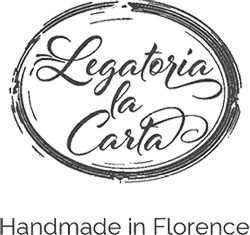- No products in the cart.
About Legatoria la Carta
A Frenchwoman living in Florence, Arielle Benozio created her bookbinding laboratory in 2007. The idea was to enhance the production of traditional Florentine notebooks by modernizing colors and mixing them with other materials, while remaining an all handmade production and Italian binding workshop.
Located in the Oltrarno, the traditional area where craftsmanship is at work in Florence, between the Palazzo Pitti and the Boboli Garden, 5 min away from the famous Ponte Vecchio, Legatoria la Carta develops a wide range of notebooks, sketchbooks and albums handcrafted with Italian materials like Italian veal, Italian paper and marbled paper made in the laboratory (you can even book a session to have a look at the process) and all kind of materials dedicated to binding. The only exception are the katazome shi papers from Japan used by Arielle to realize lines of sketching albums and notebooks, because, like the marbled paper which is a wonderful material, katazome papers are also very beautiful.
In the end, all notebooks are unique and luxurious !
WHAT MAKES PEOPLE WANT TO BUY FROM
LEGATORIA LA CARTA ?
LEGATORIA LA CARTA ?
« I believe that our customers find our notebooks beautiful and unique and like them because they are handmade with high-quality materials from Italy and Japan – two countries famous for the quality of their papers -, but also because they are made according to the art and tradition of bookbinding.
I often hear clients complaining over notebooks they bought from competitors because some of the pages come out of the notebooks: this means that, for a buyer, the quality of the product itself is as important as its aesthetic, thus the importance of our savoir-faire as a bookbinding laboratory.
It takes time to learn this craft; bookbinding is an old tradition but it’s still done now as it was made 300 years ago. So many operations are necessary to make a notebook :
- choose the right paper
- cut the sheets
- fold the paper in booklets
- sew the notebook and glue it
- cut it again to have a smooth side
- make the cover (cutting the cardboard, glueing paper on one of the
side to counterbalance the effect of the paper on the other side,
cutting the paper cover…

Plus when you make your own marbled paper, you have to prepare the bath (water and glue, or seaweed), prepare the colors, sprinkle them on the bath, make the design, put the paper on the bath, let the paper dry… In conclusion, it takes experience and time, a lot of time to make a nice and well-done notebook. An amateur of stationery is very attentive about the quality and origin of the paper, its texture, the opening of the notebook, because when you want to write or draw you don’t want to have to force it open and risk ruining it.

That’s why our notebooks are unique (each notebook being made with a handmade marbled paper, impossible to replicate to the detail), carefully made (sometimes you can find a defect but it’s due to the fact that it is handmade without the use of electrical machines)… in a word:
luxurious.
Our papers too are unique because they are handmade, they are a creation made of colors and patterns which belong to us. Japanese papers are beautiful too and some of them are not easy to find on-line but are bought directly in specialized shops in Tokyo or Kyoto.
Another particularity of Legatoria la Carta is that we offer the possibility to make notebooks in any possible size, not only A6, A5 or A4, because we cut and fold the paper as we want.

I got into this industry because, when I arrived in Italy 20 years ago, I had to stop working. I was a PR professional in Paris but couldn’t find a job in Florence as I was unable to speak Italian, and having a baby daughter to raise. I’ve always wanted to work with my hands (I studied artistic framework once) and I’ve always loved books and notebooks,
paper and stationery. I remember having bought my first Nepalese paper in New York when I was living there 25 years ago. One day, walking on the Oltrarno (the place where you can find al the laboratories in Florence), I met a bookbinder (a maestro) and decided to learn the art of bookbinding. When he retired, I decided to create my own company and settle it in the same laboratory in 2007.
At that time, I was fed up with working for a company (I had a very bad experience coming back from my maternity leave) and was looking to become independent. I’m so happy today to work in the middle of piles of papers and the smell of leather. I live in the Tuscan countryside but I love arriving every morning in the city, driving along the famous Michelango drive, 1,8 km through cypress trees and maritime pines, stopping for a coffee on the « piazzale » where there’s the famous David and the breathtaking view upon Florence. Every day I tell myself how lucky I am when I arrive via Romana, in the traditional area for craftsmanship, 5 minutes away from the Ponte Vecchio.

That’s why I try to share this passion for my work and this place when I talk to my clients. Speaking three languages helps me to meet English, American, French or Japanese customers on fairs, communicate my passion to people. Now I finally understand why I chose to work in PR before, because I like sharing with people. It helps me a lot to look at the tendencies, understand what people like. I believe that descending from different cultures (my grandparents where from Turkey – another great country for marbled paper) and being a French woman living in Italy makes my notebooks different (that’s what I like to believe). »

